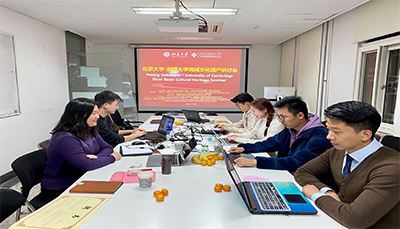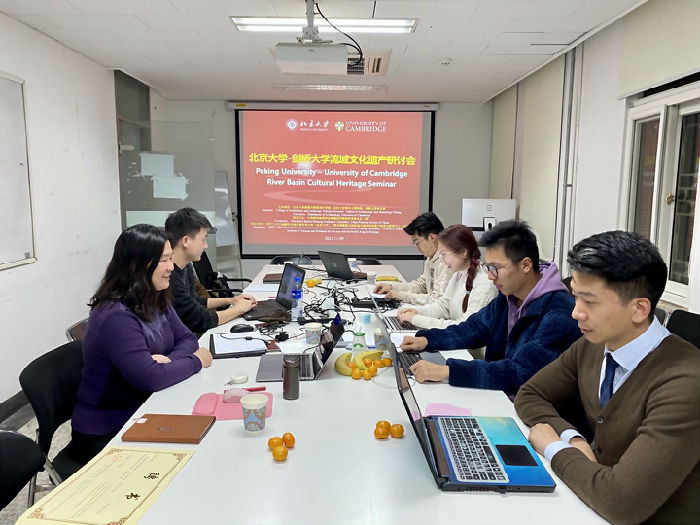


On 9 November 2021, the River Basin Cultural Heritage Seminar was held online. This seminar, which was sponsored by the College of Architecture and Landscape and the School of Archaeology and Museology (Peking University, China) as well as the Department of Archaeology (University of Cambridge, UK), co-sponsored by Watershed Spatial Planning Academic Committee, Urban Planning Society of China (UPSC), aimed to establish international academic communication to support cultural heritage and archaeological work in the UK and China.
The seminar was supported by several institutions and various people. It was hosted by Prof. Fang Wang’s team from Peking University and organized by the NSFC-DFG Sino-German Cooperation Group on Urbanization and Locality (Peking University) and UNESCO World Heritage Institute of Training and Research for the Asia and the Pacific Region (Beijing). Prof. Fang Wang is also a member of academic working committee of the UPSC, as well as the sponsor of Watershed Spatial Planning Academic Committee. Prof. Ruiwen Shen, Prof. Nan Shi (Executive Vice Chairman and Secretary-General of the UPSC),Prof. Bin Lv (Vice President of the UPSC), Prof. Marie Louise Stig Sorensen, and Dr Yun Li gave opening addresses. Prof. Changchun Feng(standing director of the UPSC, one of the co-sponsors of Watershed Spatial Planning Academic Committee) and Prof. Marie Louise Stig Sorensen cooperated to chair the seminar.

Source:https://news.pku.edu.cn/xwzh/f7eb5503cfcc4c5f9e22a2f88628512e.htm
Five keynote speeches were presented during the seminar. Prof. Jianxin Wang from the Northwest University in China presented a speech entitled ‘The Practice and Concept of Cultural Heritage Protection & The Protection of Culture Heritage in the Yellow River Basin’. In his speech, he introduced two important concepts for heritage conservation: adaptive use based on law and sharing. He held that the concept of ‘exploiting rationally’ that is commonly used in China should be replaced with ‘adaptive use based on law’ since ‘exploitation’ in the Chinese context is viewed from a top-down perspective that may dispute the sanctity of heritage, while the concept of ‘rationally’ tends to make people judge subjectively in a way that can lead to bias. ‘Adaptive use based on law’, in contrast, can mean to use heritage in contemporary life to support the development of human society as well as to use heritage objectively. As for ‘sharing’, it emphasizes that heritage belongs to all human beings, instead of exclusively belonging to someone in traditional society.
Prof. Marie Louise Stig S?rensen from the University of Cambridge gave a keynote speech entitled ‘The River and the Site’. In it, she introduced her research based on the Bronze Age tell of Százhalombatta, Hungary. By testing four assumptions – ‘the relationship to the river as definitional for the site’, ‘rivers are communication and trade arteries’, ‘river positions as a matter of defense and control’, ‘rivers as an economic resource’ – she found that while the Danube did not play these roles for the tell, it may play roles in the transportation of bulky materials and the provision of food or pebbles for people. She proceeded to highlight that while rivers cannot always play the significant roles they are popularly assumed to have, they can be important for some more subtle purposes, which should make researchers think more carefully when they research rivers.
The following speech, given by Prof. Wei Huo from the Sichuan University in China, concerned ‘Sanxingdui Archaeology and historical and cultural heritage’. Prof. Wei Huo provided many details about and pictures of the new archaeological excavation of Sanxingdui, giving the audience a closer look at the mysterious heritage. He noted the signs of power and social estate in Sanxingdui Bronze Age culture were gold truncheons, gold face masks, bronze head sculptures and huge bronze figures. He held that as they were similar to the cultural elements of the ancient Eurasian civilization, the matter of whether or not there are links between them should be given attention. As for the future planning and development of Sanxingdui, he indicated that deeper archaeological research should be conducted, the establishment of the new Sanxingdui Museum and the National Sanxingdui Archaeological Park should be accelerated and the interpretation of Sanxingdui to the public should be improved.
Dr Liliana Janik from the University of Cambridge presented a speech entitled ‘River landscapes: metastable ecosystems and ontological security in the past and the present’. Taking the concepts of ‘metastable ecosystems’ related to ecology and ‘ontological security’ linked to politics and social science, she considered the relationship between them in interpretations of Shinano River heritage in Japan. In her research, she found that the areas along the river experienced many disasters in the history. But at the same time, there are a lot of heritage created and preserved by people, such as the statue ‘Man overcoming snow’。 The heritage related to it was and is used to build Japanese national identity from archaeological and heritage data. Particularly, the heritage is used as material cultures in museums and arts.
The last speech was given by Prof. Binfu Zhao from Jilin University, China, entitled ‘Bronze Culture in Liao River Basin’. Liao River, located in northern China, is one of China’s five mother rivers. In his study, Prof. Binfu Zhao determined that the archaeological culture in Liao River Basin in the Bronze Age could be divided into four stages from the temporal perspective and four regions from the spatial perspective. By analyzing the temporal and spatial relations of pottery, he found that the Bronze Age culture in Liao River Basin could be divided into five cultural systems, symbolizing five of the ethnic groups there.
Showing appreciation to the speakers, Dr Dacia Viejo Rose from the University of Cambridge emphasized that environmental issues are significant for heritage preservation considering the ways elements in heritage sites interact with each other. She held that it is necessary to preserve heritage as a system considering ecological and environmental elements. Prof. Zhongshu Zhao (Vice chairman of Academic Committee of historical and cultural city planning, UPSC) from the China Academy of Urban Planning and Design, as a commentator, expressed gratitude and gave honest comments to speakers. Particularly, he agreed with Dr Liliana Janik’s opinion that heritage being used as material cultures, such as souvenirs, has important positive effects, and can lead to children and the public learning more about heritage even if most souvenirs are eventually discarded. He held that people should pay more attention to use heritage to educate the public.
The seminar, which was presented in English and Chinese simultaneously, was livestreamed and was watched by around 10,000 people. The event has been since reported by the official website and official microblog of Peking University, the Chinese and English versions of Chinese Social Science Today, since the seminar coincided with the Chinese government’s current attention on support for Chinese archaeology and heritage, and the Cambridge Heritage Research Centre Bulletin. It was also recommended by Built Heritage and Heritage Architecture (WeChat Subscription). Furthermore, the seminar provided a great opportunity for scholars from China and the UK to learn more about each other and exchange ideas about cultural heritage in relation to river basin environments.
Author:Lin Shiting(University of Cambridge),Yang Yiming(Peking University)
Contributed by Watershed Spatial Planning Academic Committee, Urban Planning Society of China